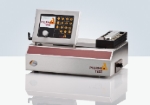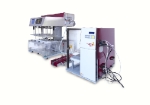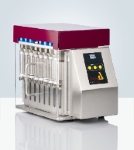
Il PTB-M è un durometro manuale per compresse, portatile e di facile utilizzo.

Il PTB-M è un durometro manuale per compresse, portatile e di facile utilizzo.


The PT-SV100 Scott Volumeter determines bulk density of powders according to the following standard Monographs: ISO 3923-2 (metallic powders): determination of apparent density, EP <2.9.34.1> USP <616, Method II> bulk density and tapped density of powders and method II, ASTM 32990 standard test method for apparent density of metal powders and compounds. The PT-SV100 is applicable to powders including metal powders, compounds, pigments, and so on that will flow freely through a suitable nozzle. A comparison of the bulk and tapped densities of powders can give an indication of the type of interaction present between the various particles building up in the powder mass and hence provide an index of powder flowability, e.g., the Hausner ratio and compressibility index Operating Principle The operating principle relies on the measurement of a mass of a certain quantity of powder which fills a container of a known volume inside the PT-SV100. A loose packing condition is obtained by using the PT-SV100 and this is achieved by filling a stainless steel cup or container by cascading the powder sample over a series of inclined glass baffles within a baffle box. The ratio between the mass and the volume represents the apparent density. The ST-SV100 is easy to use. First weigh then place the stainless steel cup onto the base of the unit. Then carefully pour the powder into the funnel at the top of the baffle box until the cup beneath overflows. Now level off the powder using a flat edge scraper. Re-weigh the cup and calculate the weight of the collected powder sample. Now use the known volume of the cup to calculate the apparent density. This can be done using the formula: p = M/V Where ρ is the density, M = mass in grams and V = volume of the receiving cup in mL. The result is expressed in g/mL.

DSR-M Dissolution Sampling Robot Manual sampling from a dissolution test instrument is not only time consuming but also limits the reproducibility and is close to impossible if sustained release products have to be analysed over prolonged time periods. The Pharma Test DSR-M (Dissolution Sampling Robot) provides a neat solution to this automation procedure. The DSR-M automated dissolution sampling robot is designed specifically for the sample transfer and sample processing from a 6 to 8 (DSR-M8) or a 12 to 13 (DSR-M13) vessel dissolution bath. This unique and versatile instrument allows collecting, dilution and/or processing samples over very short time intervals. It can also be used for dissolution medium replenishment to conform to USP/EP volume loss rules. Up to twenty sampling cycles can be run automatically. The sample preparation station, Z-arm and needle, can be used to dispense into Septa sealed HPLC vials or dilute samples. Keeping the samples in sealed vials helps avoiding evaporation, especially if sustained release products are tested. The DSR-M is the first such system to be equipped with high precision valve-free piston pumps. Each channel contains a miniaturized valve-free pump element which ensures reliable precision (<0.5%). and accurate sample delivery (<1%) for each working channel. No time consuming pump calibration is needed. The advanced design of the system means that it is always ready for operation and as the pump is already built-in the system saves a lot of bench space. The separate rinse pump is invaluable to keep the system clear of crystallizing material, especially when using buffered media. The DSR-M is equipped with two collection racks. Each rack has the capacity to store up to ten sampling cycles. In case sample processing, such a dilution is enabled, the first rack is used for collecting and the second rack for sample processing. The innovative rack design makes it possible to use the same racks for standard open vials as well as for septa sealed HPLC vials. The DSR-M is contained in a clear view Plexiglas enclosure. After the sampling is completed the rack can easily be pulled out and removed to transport the samples for analysis. In case additional filtration besides the sinter filters on the sampling probes is required, we offer the MFC-12 manual filter changer. With this filter changer it is possible to conveniently exchange a filter for up to 12 channels in the dissolution system. The MFC-12 is installed into the tubing system of the dissolution system and can quickly be opened using the two open and close handles. When the MFC-12 is opened, the filters are automatically disconnected and can be removed quickly. New filters can then be inserted and are automatically locked into the tubing connectors, when the MFC-12 is closed again. Since these round filters can pass liquid only in one direction, a bypass is needed to use the MFC-12 in a DSR-M system with CAT-M piston pumps. For this we offer the DSR-MSV valve station in multiple models according the number of channels in the automated dissolution system. All necessary sample handling information, such as dilution factor, sample transfer into empty septa closed vials is directly entered at the DSR-M using the integrated keypad. The programming is displayed clearly on the back lit LCD screen. Alternatively the DSR-M can be controlled by a connected Pharma Test dissolution testing instrument. In any case no additional PC software is required to use the DSR-M. Usually the sampling probes inside the dissolution testing instrument are connected to the EPE auto sampling manifold, which is available for PTWS 310, PTWS 610, PTWS 1210 and PTWS D610. The motorized EPE lowers the sample probes into the corresponding sampling position which is pre-set for either 500 or 900 ml total media volume. A trigger signal starts the DSR-M sampling pumps so that the preset volume is withdrawn and dispensed into the vials or tubes which are in the sample racks. Only one sample line is required from the dissolution testing instrument via the sampling manifold since all liquid sampling and refilling is made through the same tubing. So no need for extra return tubing for refilling and automated tube flushing previous to the consequent sampling interval. A typical automated System including the DSR-M includes the following equipment: PTWS 310 dissolution testing instrument, a manual tablet drop magazine, the EPE auto sampling manifold, PTFE tubing installation, and the DSR-M8 dissolution sampling robot. Features Features valve free piston pumps for high precision Modular design to allow auto media refill, dilution and transfer into selaed vials for six to twelve station dissolution baths Up to 20 sampling cycles (10 cycles with dilution) Less than 1% transfer error Supports 0.45 micron filtration using MFC-12 manual filter changer and DSR-MVS valve station Sampling sequences are programmed direcly at the Pharma Test dissolution bath Stand-alone mode available to support third party dissolution baths

PT-TD300
Tapped and Apparent Density Testing Instrument
PT-TD300 is used to test the tapped (or “tamped”) density and apparent density of powders, granules, pigments and similar products in compliance with the current USPmethods 1 and methods 2 as well as with EP, DIN EN ISO 787-11 and ASTM B527. The instrument automatically calculates the tapped density, Hausner flowability ratio and Carr compressibility index after each test and documents the results via the integrated protocol printer

PT-SP High Precision Multi-Syringe Dosing Pump Features Features 6 or 8 high precision 10 ml glass syringes Pinch valves for flow control, easy to service, very low blocking risk Modular design to allow auto media refill, or extension to sample from and replace into up to 16 vessels Sampling sequences are programmed directly at the Pharma Test dissolution bath

Orodispersible films (ODF) are a novel dosage form. Since 2012, they are monographed in European Pharmacopoeia (Ph.Eur. 7.4). Despite the fact that there are several film products available on the market, there has been no specific test method defined to characterize this dosage form.
The new PT-ODF test basket for the PTZ AUTO EZ tablet disintegration testing instruments closes this gap by offering a simple and affordable device to reliably test the disintegration times of films. The PT-ODF basket can be used with any existing Pharma Test PTZ AUTO EZ instrument without any need for modification
The PTG-NIR automatic powder and granule inspection system with an integrated J&M NIR spectrometer may be used to examine the flow characteristics of a powder or granule. The combination of a powder testing system with a J&M NIR diode array spectrometer is ideal for simultaneous detection of chemical, physical and morphological information. This information is describing the flow behaviors of a powder or granule. Other forms of solids are possible to be tested too. All the results are in a single report generated by the TIDASDAQ3 software.
